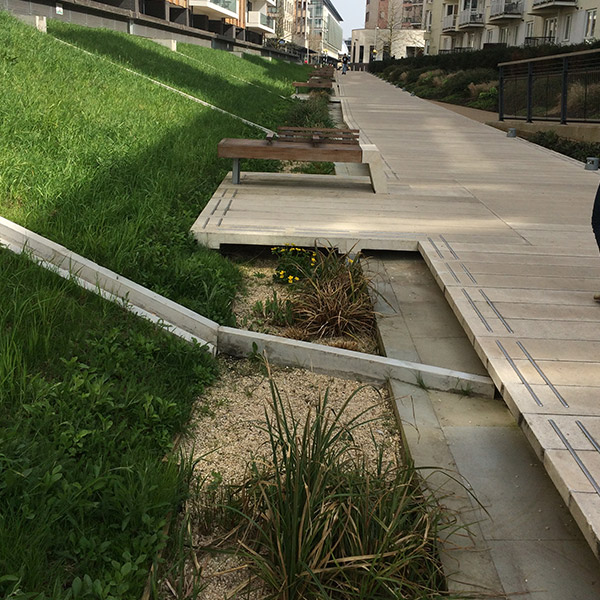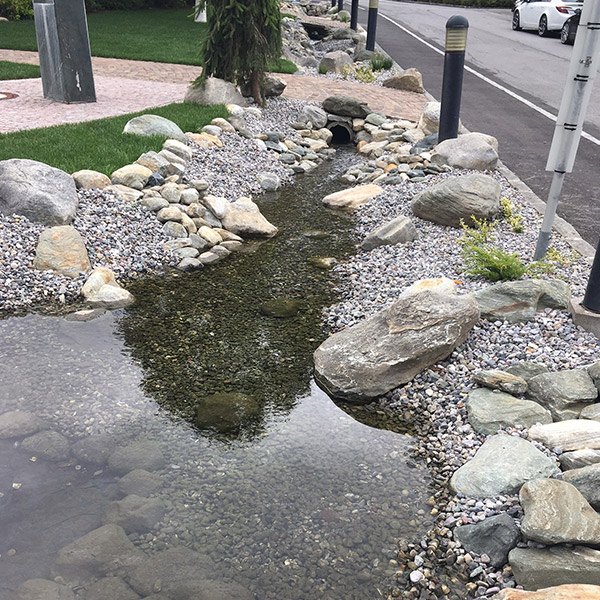Rain gardens are designed to help reduce flood risk and improve water quality, biodiversity, and public amenity. Rain gardens are excellent examples of how SuDS components can be integrated into a streetscape without negatively impacting the primary function of our streets and spaces. They can be planted with a wide variety of species depending on the context and demands of the site. They should not only be considered in flood risk areas, integrating rain gardens into public realm projects can provide substantial added value.
Designing spaces that can adapt not only to the constantly changing urban environment but to the ongoing climate changes is important. Rain gardens help sustain the wider environment, keep an outdoor space usable for most of the year, and, especially on sloping gardens, can help avoid erosion (https://www.rhs.org.uk/garden-features/rain-gardens).
Rain gardens can absorb up to 30% more water than a lawn, and don’t need mowing (https://www.rhs.org.uk/garden-features/rain-gardens). And by reducing the risk of flooding, they also reduce the pollution risks associated with flooding (because run-off washes oil, heavy metals, and pollutants from roads, etc into watercourses).
They can also be used to harvest rainwater, helping to reduce the effects of drought, and cut down on the need for watering.
And, last but not least add biodiversity to the list of benefits.
Rain gardens can vary in size. Bigger gardens (and therefore storing more water) increase the flood risk management benefit, however, this needs to be balanced against cost and availability of space. A typical highway gully drains a catchment area of around 200m2. As a general rule a rain garden should be 5-10% of the catchment area hence, 10-20m2 for a rain garden drains the same area as a typical gully. A good aim is to store the first 20mm of rainfall – in London, this is the estimated depth of rainfall for an hour storm with an annual probability of 1 in 5. Storing this amount of water contributes to reducing flood risk. Storing more water is even better if there is adequate space to do so (https://www.urbandesignlondon.com/documents/85/UDL_Rain_Gardens_for_web_0vwx1Ls.pdf).
Rain gardens should be designed to maximise the amount of water that can infiltrate into the sub-soil as this relieves pressure on the piped drainage network, replenishes groundwater, and supports the baseflow in rivers. It is important to ensure that rain gardens do not become water-logged and have enough storage capacity available for the next storm event and at the same time to ensure the rain garden attenuates inflow effectively and does not drain down too quickly. If the rain garden drains too quickly it could increase pressure on the drainage system rather than relieving it. Rain gardens can also be retrofitted into an urban landscape and existing drainage features such as gullies can be retained as overflows.
Rain gardens can be planted with a wide range of different plants. Different planting specifications provide a range of different benefits. Trees provide a good growing environment with more irrigation and un-compacted soil. Shrubs will enhance soil stability. Perennial flowering plants will provide year-round interest. Grasses can be particularly effective at filtering pollutants from highway runoff. Wildflowers comprise meadow species that contain perennial and annual flowers, often mixed with grasses, these are a relatively low-cost option that can thrive in low nutrient and free-draining soils. Marginal plants such as reeds, rushes, and sedges are suited to damp or waterlogged conditions.
The cost of installing a rain garden is comparable to the cost of paving the same area, as both paving and rain gardens require excavation and the construction of a suitable sub-base. Rain gardens can be incorporated into schemes in areas that would otherwise be paved, such as traffic calming buildouts, without significant additional costs. Similarly, rain gardens can usually be integrated into existing green spaces at minimal extra cost. As they are flexible in design, the make-up and planting of a rain garden can be adjusted to suit site constraints and budgets. The greatest cost benefits are achieved where rain gardens are integrated into the design at an early stage. SuDS solutions such as rain gardens reduce the amount of silt, litter, and other debris entering gullies and pipework – consequently, they reduce the risk of blockages and potentially reduce maintenance costs. In some cases, they can eliminate the need for piped drainage completely. In terms of maintenance, both SuDS features and conventional drainage systems require regular maintenance to perform adequately. The key difference here is that SuDS are generally visible and relatively straightforward to maintain. Maintenance requirements can be identified and remedied relatively easily while issues with conventional drainage systems are often only realised when they fail. These unexpected results can potentially be very expensive to repair (https://www.urbandesignlondon.com/documents/85/UDL_Rain_Gardens_for_web_0vwx1Ls.pdf).
If you would like more information about how you can incorporate rain gardens within your project, please contact either our Landscape Architecture team today on 01666 825646 or email your query to mail@acdenv.co.uk.


